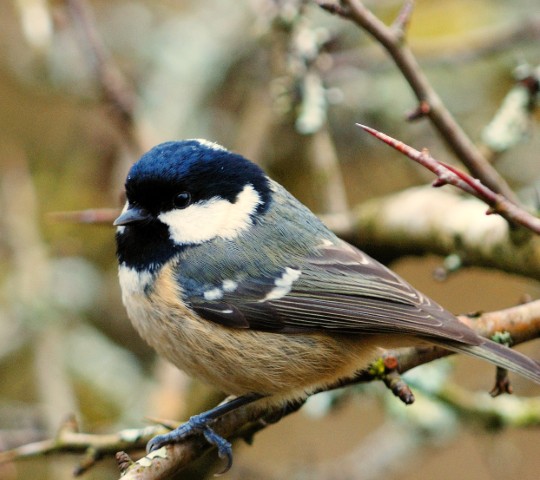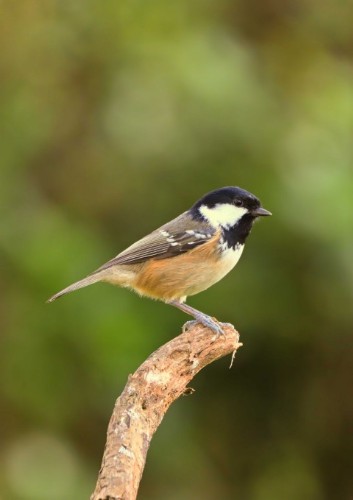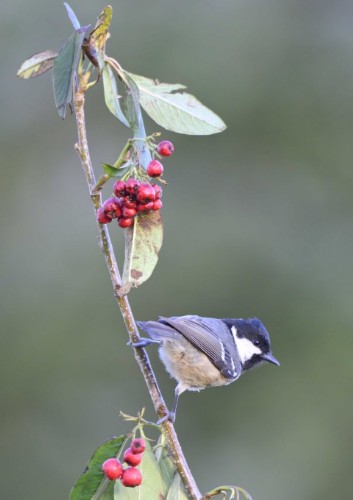Coal Tit, the Survivor
Reports

In October 2025, there were widespread reports of larger than usual numbers of Coal Tit at garden feeders on Arran. including twelve in Lagg on 8th and twelve in Corrie on 18th . The bird ringing team on Arran report that a larger than usual proportion of these birds are juveniles reflecting a successful breeding season. In addition the cone crop from earlier in the year is finished, so food provided in gardens is particularly welcome.
In Scotland, Coal Tit is a common breeding bird throughout most of the mainland and most of the islands with the exception of the Northern Isles. It is absent from exposed treeless areas and in the twentieth century benefited from the establishment of conifer plantations. The winter distribution is very similar to that in the breeding season and reflects the generally sedentary nature of Coal Tit in Scotland.
Primarily a bird of coniferous woodland, even quite small, isolated stands of conifers in deciduous woodland are sufficient to support breeding birds. But they are also found in birch and oak wood. A woodland species, Coal Tit readily come into gardens, especially if there are conifers. A wide variety of foods, especially peanuts and sun flower seeds, will attract the species to feeders.
The smallest of the European Tits, Coal Tit tends to get picked on by its larger relatives and is at the bottom of the tit pecking order. When able to get to garden feeders, a Coal Tit will often fly off with a seed or nut, only to return seconds later for another, repeating the action many times. The bird stores the food to eat later. Like a lot of small birds they spend most of the daylight hours feeding, waking early and roosting late.
Coal Tits nest naturally in holes in trees and stumps, under roots or rocks and in holes in the ground. They will use nest boxes with small holes. From BTO information they were the 10th commonest bird to use nest boxes. A nest box for a Coal Tit is best sited low down where other tits are unlikely to use them. Coal Tit is the earliest of our tits to breed, beginning in late April, when nine or ten eggs are laid. The incubation is about fourteen days and after hatching both parents feed the young for about twenty days. There is normally only one brood. Coal Tits breed when they are one year old and the average lifespan is two years. This breeding technique of a single large brood can help to re-establish numbers after a severe winter.
The smallest of the European Tits, Coal Tit tends to get picked on by its larger relatives and is at the bottom of the tit pecking order. When able to get to garden feeders, a Coal Tit will often fly off with a seed or nut, only to return seconds later for another, repeating the action many times. The bird stores the food to eat later. Like a lot of small birds they spend most of the daylight hours feeding, waking early and roosting late.
Coal Tits nest naturally in holes in trees and stumps, under roots or rocks and in holes in the ground. They will use nest boxes with small holes. From BTO information they were the 10th commonest bird to use nest boxes. A nest box for a Coal Tit is best sited low down where other tits are unlikely to use them. Coal Tit is the earliest of our tits to breed, beginning in late April, when nine or ten eggs are laid. The incubation is about fourteen days and after hatching both parents feed the young for about twenty days. There is normally only one brood. Coal Tits breed when they are one year old and the average lifespan is two years. This breeding technique of a single large brood can help to re-establish numbers after a severe winter.
Coal Tits are survivors. Their food hoarding habits, their tendency to feed from the snow-free undersides of branches as well as their ability to take advantage of food provided in gardens, all help Coal Tits to be relatively unaffected by snow or cold in winter. However long periods of very severe weather may cause high mortality. After their successful breeding season, I would be particularly interested in receiving records of this species throughout the winter.
Enjoy your birding.

